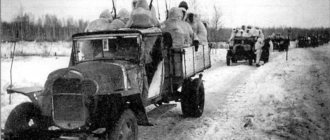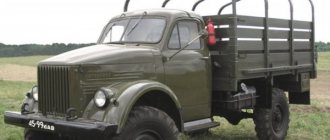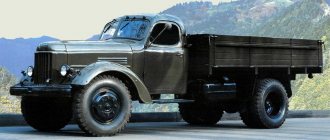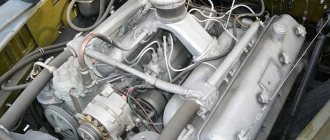Organization of a trophy fleet
Soviet soldiers next to Opel Blitz and Olympia cars
The use of captured vehicles by units of the Red Army began from the first days of the war. According to the most conservative estimates, in the first six months, the Germans lost 35 thousand trucks and 25 thousand cars. As a result of the winter counteroffensive near Moscow, the Red Army captured 15 thousand vehicles. Typically, captured vehicles were included in the units that captured them. From them freelance motor vehicle battalions were formed, where the number of cars was regulated only by their availability.
Vehicles often fell into the hands of the Red Army in a badly damaged condition requiring repair. In this case, vehicles that could not be repaired on site were sent to the rear to the repair bases of non-profit organizations and automobile industry enterprises. For example, MosZIS restored 14 thousand cars during its operation. Trophies unsuitable for restoration were dismantled into spare parts, which were sent to front-line warehouses for armored vehicles, the rest was sawn into metal.
Opel Blitz on the march
During the successful operations of the Red Army on the Volga in 1942-1943. 80.5 thousand vehicles were captured. Moreover, 70% of them were subject to restoration. However, by the end of the summer of 1943, the evacuation of captured cars to car factories was no longer carried out. Automotive companies were engaged in the repair and maintenance of domestic and Lend-Lease vehicles. Front-line bases and workshops were engaged in restoring enemy vehicles. After repairs, they were first sent to mechanized units.
It is not known for certain how many captured cars served in the Red Army. By the end of the war, their share in the troops was estimated at 9.1% (about 60.5 thousand vehicles).
Main enemy's main truckSergey Shumakov
On the pages of our portal we have already talked about the Soviet military truck ZiS-5 Studebaker, a front-line worker . However, the main truck of the main enemy remained unattended, and our readers were quick to notice this, and since then they have been asking us to tell us about the main truck of the Wehrmacht. Fulfilling these numerous requests, today we will talk about the Opel Blitz .
And we will begin the story about this car with one interesting and instructive story. In 1944, during Operation Bagration, a German battalion retreating from Soviet troops stopped in a Belarusian village. By that time, the battalion had 16 serviceable vehicles left. And at night, when the Germans settled down in the village for the night, local boys stole the crank handles from each of the cars. At dawn, the roar of the advancing Thirty-Fours awakened the Germans. They rushed to the cars to immediately take to their heels, but they couldn’t start them. Half an hour later, Russian tanks surrounded the village on three sides, and the Germans had to retreat on foot. Sixteen pieces of equipment went to the advancing Soviet troops. This could only happen because the Opel Blitz was not equipped with an electric starter and had magneto ignition.
The importance of a truck in war is difficult to overestimate.
Tanks and armored personnel carriers are helpless without them. This was shown already in the first days of the war. Few people know that the troops of the Southwestern Front already launched a counteroffensive on July 23, 1941, which successfully continued until the 28th-30th. And the Germans ran. Moreover, the 8th Mechanized Corps, having connected with the 15th in the Dubno area, and our tankers encircled the 11th and 16th German tank divisions. However, at the very height of the operation, our tanks ran out of both fuel and shells, which is why the crews had to abandon the tanks and retreat to Kyiv on foot through the forests. All this happened due to the fact that business executives made a mistake in their calculations, providing each tank division with only 160 ZiS-5 and a half.
But even these cars did not have time to be mobilized from the national economy by the beginning of the war. The Germans intended about 500 trucks to support only an infantry division, while tank and motorized divisions were provided with 1600-1800 vehicles. That is why the Germans almost never ran out of fuel and ammunition, while ours had constant supply interruptions until 1943.
The Opel Blitz is considered the best three-ton truck of the Wehrmacht and, at the same time, it is the only truck that was produced throughout the war until the defeat of Germany. Production took place at Opel's purpose-built car plant in Brandenburg, “an exemplary National Socialist plant.” Since 1944, Daimler-Benz has also joined the production of this car. Of the 129,795 three-ton Opel Blitz trucks produced, approximately one hundred thousand were delivered to the Wehrmacht and the SS troops, the rest were used in the defense sectors of the German national economy.
One of the Blitzes captured in
Battle for Moscow
The Opel Blitz was equipped with a six-cylinder carburetor Reihenmotor (Reihenmotor - in-line engine) from the Opel Admiral passenger car with a displacement of 3626 cubic centimeters. Its cylinder diameter was 90 mm, piston stroke was 95 mm. At 3120 rpm, the engine produced 73.5 horsepower, which coincided with the same figure for the ZiS-5 , but with a working volume 1.41 times smaller. The engine crankcase was aluminum, and the block and head were made of gray cast iron. For 100 kilometers, the car consumed 26 liters on an asphalt highway and 35 liters on a dirt road. The 84-liter fuel tank provided a 320-kilometer range. The transmission used a dry single-plate semi-centrifugal clutch and a five-speed gearbox.
The main advantage of the car was its high speed - on a good road the Opel Blitz walked at a speed of 90 km/h, while the ZiS-5 developed only 50. The reason for this advantage was the use of the same gear ratio in the final drive, equal to 43/10, as in Admiral. However, this decision led to the fact that it sharply limited the weight of the towed trailer, and generally excluded the possibility of using the trailer off-road.
The compression ratio also had a passenger-car value - six units, which required the use of first-grade gasoline and therefore practically excluded the use of captured gasoline on the Eastern Front. Therefore, in January 1942, production began of a modification with a reduced compression ratio in the engine, thus adapting it for the use of 56 gasoline, and an increased gear ratio in the main gear. Power dropped to just 68 hp, but speed dropped to 80 km/h. And in order to maintain the same power reserve, the volume of the fuel tank was increased to 92 liters, since consumption increased to 30 liters on asphalt and 40 on primer.
Since the management of GM, which then owned Opel, opposed the production of military products, the Opel Blitz was late by the start of the war - until 1940, only a civilian version was produced. But in 1940, the enterprise was nationalized, and the military Blitz began to enter the troops.
In the front-line units of the Wehrmacht and SS troops, Opel Blitz were used not only for transporting personnel and cargo, but also as a chassis for installing 20- and 30-mm anti-aircraft automatic guns. On the basis of the same chassis, many special vehicles were created - mobile radio stations, ambulances, various workshops, buses, etc. In addition to the Opel Blitz truck with a carrying capacity of 3 tons, vehicles unified with it were produced with a smaller carrying capacity and with a less powerful 55-horsepower engine from the 2.5-liter Opel Captain passenger car. This was done to reduce fuel consumption. the Mercedes-Benz 260 D was also installed on the Blitz (about it - TuT ). This engine, with a cylinder diameter of 95 mm and a piston stroke of 100 mm 100 mm, had a displacement of 2545 cc. cm. The compression ratio was 20.5 units. At 3000 rpm it produced only 45 hp. s., which was clearly not enough for a three-ton truck. One of the options was equipped with a gas generator. Another ran on methyl alcohol - the longer the war went on, the less gasoline was available.
There were a total of 16 sizes of this truck. To increase the cross-country ability of the standard three-ton Opel Blitz S, its half-track version, the Maultier mule, was developed and mass-produced. At the end of the war, in order to reduce labor costs and save metal in the production of trucks, the design of some parts was simplified; the vehicles were produced with an ersatz cabin made, like the ZiS-5 , from wood.
Previous days in Russian history:
Why is the steering wheel on the left? Degradation of US nuclear forces The feat of Panfilov's heroes Should we feel sorry for the Japanese? How England loved Russia Salaries in the CIS countries Shiryaev's AO-27 assault rifle English tanks Japanese tanks → Russian tanks → American tanks → Balaton operation Berlin operation Battle of the Caucasus Battle on the Rogachev highway Battle near the village of KushchevskayaArmored trains of the Great Patriotic War Introduction of shoulder straps in the Red Army Capture of Budapest Capture of B ena Capture of Königsberg Military battle by Zinovia Kolobanova East Prussian operation Vyborg offensive operation Vyazma airborne operation Vyazma cauldron Dnepropetrovsk operation Road of life Yelets operation Zhitomir-Berdichev operation Banner of the Great Victory Kerch-Feodosiya landing operation The end of Paulus's army Counter-offensive of Soviet troops near Moscow Counter-attack near Soltsy Korsun -Shevchenkovskaya operation Kotelnikovsky operation Battle of Kursk Lvov-Sandomierz operation Malaya Zemlya German attack on the USSR Lower Silesian operation
Insignia of service categories of the Red Army 1924-35
| Rank insignia of the Red Army 1935-40 | Rank insignia of the Red Army 1940-43 |
| See also: | |
| Number and percentage of Russians by regions of the Russian Federation | |
| Should we feel sorry for the Japanese? | |
| Peoples of Russia, their number and percentage | |
| Soviet aces of World War II | |
| It was impossible to do without the Molotov-Ribbentrop Pact | |
| Gold reserves of countries around the world | |
| Gold and foreign exchange reserves of the world's countries | |
| Does Russia need a gold ruble? | |
| How America Got Rich | |
| Rating of countries in the world by the number of armed forces | |
| Who sold Alaska and how | |
| Why we lost the Cold War | |
| The mystery of the 1961 reform | |
| How to stop the degeneration of a nation | |
| Why were Chechens and Ingush deported in 1944? | |
| Which country drinks the most? | |
| Which country has the most murders? | |
| How did the Russian worker live before the revolution? | |
| What is the value of the Soviet ruble in today's money? | |
| What Russia exports and what it imports | |
| History of the Moscow tram | |
| Cartoon "Guest from the Future-2" | |
| The world's first machine gun and its inventor | |
| Soviet prices for cars and motorcycles in rubles and salaries | |
Opel Blitz in the USSR
Red Army soldiers repairing an Opel Blitz, 1944
It should be noted that the range of the Wehrmacht vehicle fleet was very, very diverse. In addition to their own cars, the Germans had British, French, Czechoslovak, Italian and other cars from different European countries. German cars were not uniform either . Before the start of the war, the Wehrmacht had about 30 models of military-type trucks and a wide variety of civilian models. All this made it difficult to find spare parts and repairs. Against this background, the poor Soviet truck fleet, essentially consisting of two models: GAZ-AA/MM and ZIS-5, looked like a blessing.
The most common German truck was the three-ton Opel Blitz 3.6-36S. In terms of its overall design, this car was not a revelation for our mechanics. A standard two-axle truck with rear- or all-wheel drive and dual tires on the rear axle. Behind the double all-metal cabin there was an onboard platform on which it was possible to transport up to 3 tons of cargo. The Opel Blitz was equipped with a six-cylinder in-line petrol engine with a Solex carburetor and starter. Unlike domestic trucks, Opel cold started without pressing the accelerator pedal. In addition, the on-board electrical equipment of the truck operated at a voltage of 12V, as opposed to 6V on our vehicles. The classic spring suspension with hydraulic shock absorbers was quite durable in our conditions. The brakes, unlike Soviet cars, are hydraulically driven rather than mechanically driven.
In the Red Army, the Opel Blitz was considered a very comfortable and reliable car. Drivers appreciated it for its spacious closed cabin and soft ride. In addition, the truck consumed low-quality gasoline and oil relatively painlessly. With timely and competent maintenance, the Opel Blitz served for quite a long time, sometimes until the end of the war, and after its end it replenished civilian fleets in considerable quantities.
Design and modifications
The appearance of the car differs from its counterparts, although architecturally they are identical. The front has approximately identical optics, mated to a recessed radiator grille. The car is easily distinguished from the Zafira by its huge unpainted bumpers, where the fog lights are installed.
The profile is detailed by emphasizing the flared wheel arches and the convex lower part of the sill. There is a black molding at the bottom. There is a passenger version of the Combi where windows appear on the sides and, of course, seats inside. It will be a more utilitarian passenger car than the Zafira Life.
There is absolutely nothing surprising at the back - a flat shape with simple vertical lights and a standard convex plastic bumper.
If we talk about the electric version, its design is different. Here are other painted bumpers with a large black insert, where in addition to PTF they will add LED DRLs. A small diode strip is added to the profile, and the rear bumper is slightly changed.
Dimensions of Opel Vivaro
The buyer is offered various modifications of different sizes and, accordingly, carrying capacity.
Dimensions:
- length – from 4600 to 5300 mm;
- width – 1920 mm;
- height – 1940 mm;
- wheelbase - from 2925 to 3275 mm;
- cargo compartment volume – from 4.6 to 6.6 cubic meters.
In the maximum version, the van can withstand 1.4 tons of weight, plus you can carry a trailer weighing up to 2.5 tons.
In the national economy
Opel Blitz truck at the crossing, 1944
As the army began to become saturated with more and more new domestic and Lend-Lease trucks, captured vehicles were gradually written off in favor of the national economy. The first batches of trucks went to the rear already in 1944, but the main flow occurred in the two post-war years. Opel Blitz settled in different regions of the USSR. Basically, German three-ton trucks could be found in the western regions of the USSR: the Baltic states, Belarus, and Ukraine. They were found in smaller quantities in the central regions of the RSFSR, and only a few reached beyond the Urals and the Far East.
Demobilized Opel Blitz were often cars that were unsuitable for serious work and had long since exhausted their service life. They were restored using Soviet and German components and assemblies, and of various brands. By the end of the 1940s, an original Opel Blitz could hardly be found. The captured three-ton trucks finally disappeared from motor vehicles by the mid-1950s, by which time they were replaced by much more advanced domestic GAZ-51 and ZIS-150 .
Salon
The main cabin has 3 seats and in fact the interior is completely consistent with the Zafira. The seats are as simple as possible, they are heated and that’s all.
The driver of the Opel Vivaro 2020-2021 receives the simplest possible 3-spoke steering wheel with several buttons. The instrument panel is analog with a central on-board computer, which is quite informative. The only interesting thing on the center console is the large touchscreen multimedia display. Otherwise, nothing surprising, except for a lot of niches for small things.
The front passenger seats transform and the lower part of the pillar opens. This will allow you to transport long loads, fitting some into the passenger cabin.
The passenger version will have seats in the back. They are comfortable, but there is no additional comfort in the form of simple folding tables. The practicality of the van remains, you can fold all the seats and get a flat floor for cargo, although the capacity will be greatly reduced.
Specifications
The buyer is offered two BlueHDI diesel engines in several modifications. They are all turbocharged with common rail injection and 16 valves.
- Basic - 1.6-liter unit with two versions: 95 hp. and 210 H*m of torque, or 115 hp. and 300 H*m of torque. Its dynamics are not revealed, but consumption is promised to be 6.5 liters in the city and 5.7 liters on the highway.
- The alternative is the same engine, only with a 2-liter volume. A 155-horsepower and a 177-horsepower version is offered. Torque is 370 and 400 H*m, respectively. The engine consumes more - 7.2 liters in the city and 5.1 liters on the highway.
The base engine is mated to a 5-speed manual transmission; the rest of the internal combustion engines, except the most powerful one, are equipped with 6-speed ones. The top-end internal combustion engine is mated to a 6-speed automatic transmission, but it is not installed on Russian models.
The platform is naturally from Zafira (EMP2), so the suspension is identical - an independent design on MacPherson struts at the front and a multi-link architecture at the rear. Everything is set up a little harshly, which is normal for minivans. The brake system is all-disc, and the power steering is electric.
Electric version
The Vivaro-e is driven by a single electric motor coupled to the front axle. The installation produces 136 horsepower and 260 N*m of torque. The unit is powered by a 50 or 75 kWh battery (optional), located under the cargo compartment.
It is stated that Opel Vivaro-e batteries do not eat up the space of the compartment, but they lower the center of gravity, improving the car’s handling. In quiet mode, the batteries can travel 230 and 330 km, depending on the capacity.
They also charge differently: 30 minutes to 80% for 50 kWh and 45 minutes for 75 kWh. Naturally, the car will take longer to charge from a regular outlet, although you can speed up the process by purchasing a three-phase charger of 11.3 kW, instead of the base one of 7.4 kW.
The French (yes, not the Germans) give the buyer an 8-year warranty on batteries.
Price
In Russia, essentially two configurations are offered. The basic version costs 1,669,900 rubles, and the maximum version will cost 1,819,900 rubles.
The difference is small, and the equipment will practically not differ.
The price can be increased with options:
- air conditioning (amazing);
- Hands free;
- metallic;
- hatch in the partition;
- engine crankcase protection.
In total, the options will cost 190 thousand rubles, which is very expensive.
Yes, there are complaints about the equipment, but this is still a utilitarian commercial vehicle. The analog model is much more expensive, because it has all the comfortable functions (plus 1 million rubles). So for business, the Opel Vivaro 2020-2021 is a good option, but it’s worth studying the competitors.











